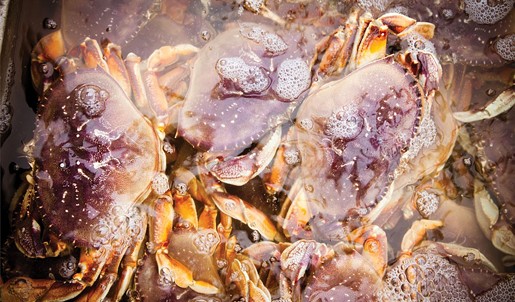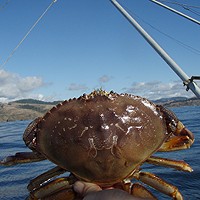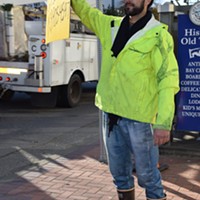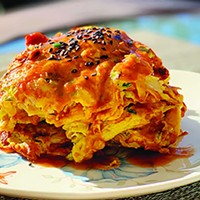Thursday, November 5, 2015
UPDATE: Hold the Crab
Posted By Jennifer Fumiko Cahill @jfumikocahill on Thu, Nov 5, 2015 at 12:35 PM
UPDATE:
The California Department of Fish and Wildlife Commission voted today to indefinitely postpone recreational crab season. It remains prohibited to take crab anywhere north of the Ventura/Santa Barbara county line until the department changes its mind.
“Closure of the fisheries shall remain in effect until [public health] determines that domoic acid levels no longer pose a significant risk to public health and no longer recommends the fisheries be closed,” a press release reads.
The season was scheduled to start Saturday. Commercial crab season is scheduled to start Nov. 15, but could be delayed if levels of toxic domoic acid don’t drop by then.
PREVIOUSLY:
Don't melt that butter just yet. With recreational Dungeness crab season scheduled to open Saturday, Nov. 7, the California Department of Public Health warns that unsafe levels of domoic acid (the same nasty stuff that ruined your clam digging fun) has been detected in rock and Dungeness crab, and warns consumers not to eat them. According to a California Department of Fish and Wildlife press release, low levels of domoic acid, produced by an enormous algal bloom, can cause "nausea, diarrhea and dizziness in humans." Up the dosage and you're looking at memory loss, seizures and possibly death.
The Office of Health and Hazard Assessment has recommended holding back the start of Dungeness crab season and shutting down rock crab fishing. The California Fish and Game Commission will vote on whether to follow those recommendations at a meeting on Nov. 5, but the CDFW will likely push the commercial season back from its planned Nov. 15 opening.
From the CDFW:
The California Department of Fish and Wildlife Commission voted today to indefinitely postpone recreational crab season. It remains prohibited to take crab anywhere north of the Ventura/Santa Barbara county line until the department changes its mind.
“Closure of the fisheries shall remain in effect until [public health] determines that domoic acid levels no longer pose a significant risk to public health and no longer recommends the fisheries be closed,” a press release reads.
The season was scheduled to start Saturday. Commercial crab season is scheduled to start Nov. 15, but could be delayed if levels of toxic domoic acid don’t drop by then.
PREVIOUSLY:
Don't melt that butter just yet. With recreational Dungeness crab season scheduled to open Saturday, Nov. 7, the California Department of Public Health warns that unsafe levels of domoic acid (the same nasty stuff that ruined your clam digging fun) has been detected in rock and Dungeness crab, and warns consumers not to eat them. According to a California Department of Fish and Wildlife press release, low levels of domoic acid, produced by an enormous algal bloom, can cause "nausea, diarrhea and dizziness in humans." Up the dosage and you're looking at memory loss, seizures and possibly death.
The Office of Health and Hazard Assessment has recommended holding back the start of Dungeness crab season and shutting down rock crab fishing. The California Fish and Game Commission will vote on whether to follow those recommendations at a meeting on Nov. 5, but the CDFW will likely push the commercial season back from its planned Nov. 15 opening.
From the CDFW:
The California Department of Public Health (CDPH) issued a health advisory warning individuals to avoid eating rock and Dungeness crab due to the detection of high levels of domoic acid. The advisory was followed by a recommendation from the Office of Health Hazard Assessment (OEHHA) to the California Fish and Game Commission and the California Department of Fish and Wildlife (CDFW) to delay the start of the Dungeness crab season and close the rock crab fishery. These actions would apply to each fishery from the Oregon border to the southern Santa Barbara County line.
The OEHHA recommendation has prompted an emergency meeting of the Commission, which will take place at 8 a.m. on Thursday, Nov. 5 (agenda and meeting information). At that time, the Commission will consider voting to delay the opening of the recreational Dungeness crab fishery. The recreational Dungeness crab season is currently scheduled to start Saturday, Nov. 7.
Also based on the recommendation from OEHHA, CDFW will act on its authority to delay the start of the commercial Dungeness crab season. The commercial Dungeness crab season is currently scheduled to start Sunday, Nov. 15 in most of the state.
Similar action will be considered by the Commission and CDFW to close the recreational and commercial rock crab fisheries in the affected area. Both recreational and commercial rock crab seasons are open all year.
"These are incredibly important fisheries to our coastal economies and fresh crab is highly anticipated and widely enjoyed this time of year. Of course, delaying or closing the season is disappointing," said CDFW Marine Regional Manager Craig Shuman. "But public health and safety is our top priority."
CDFW, along with the OEHHA and CDPH, has been actively testing crabs since early September. OEHHA announced today that consumption of Dungeness and rock crabs is likely to pose a significant human health risk as a result of high levels of domoic acid. CDFW will continue to coordinate with OEHHA and CDPH to test domoic acid levels in crab along the coast to determine when the fisheries can safely be opened.
Domoic acid is a potent neurotoxin that can accumulate in shellfish, other invertebrates and sometimes fish. It causes illness and sometimes death in a variety of birds and marine mammals that consume affected organisms. At low levels, domoic acid exposure can cause nausea, diarrhea and dizziness in humans. At higher levels, it can cause persistent short-term memory loss, seizures and can in some cases be fatal.
Domoic acid is produced from some species of the marine diatom Pseudo-nitzschia. Currently, a massive toxic bloom of Pseudo-nitzschia has developed, significantly impacting marine life along California's coast. State scientists have been testing crab from eight fishing ports from Morro Bay to Crescent City, and have determined that the neurotoxin has spread throughout the fishery grounds.
Algal blooms are common, but this one is particularly large and persistent. Warmer ocean water temperatures associated with the El Niño event California is experiencing is likely a major contributing factor to the size and persistence of this bloom.
Speaking of...
Readers also liked…
more from the author
-
Look Up for Rooftop Sushi
- Apr 19, 2024
-
Resentencing, CASA Kids and Freaky Fish
- Apr 19, 2024
-
Eco Cemeteries, Flags, Impacts and Foods
- Apr 12, 2024
- More »








































